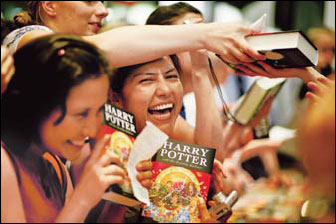Little books now big business
By Pablo Sanguinetti (China Daily)
Updated: 2010-07-21 10:00
 |
Large Medium Small |

Publishers, librarians and experts agree: Literature for young children and adults has done better during the economic crisis than other kinds of books and is expanding.
Authors and illustrators for younger readers abound. There can be even more to children's literature after the huge success of the Harry Potter and Twilight series.
"Before, there were only children's books published by the big publishers, especially religious or scholastic ones, with a very educational focus and for children older than six," says Laurence Cortes, owner of Biblioketa, one of Madrid's largest children's bookshops.
But there's been much progress since then, she says. "An enormous market has opened for children starting at zero years. And the number of local publishers, authors and illustrators who focus on the children's and young people's market continues to grow."
Cortes, originally from France, where she worked on the editorial side of publishing, opened her bookshop seven years ago. Although not enamored of them, she acknowledges that series like Harry Potter and the Twilight saga "opened the market".
"What is important is that then children pass on to something else. And that is the most difficult thing to do. Bestsellers are elemental. They seek only to awaken strong emotions, everything is obvious."
Industry statistics show a positive trend for children's books in Spain. In 2009, despite the crisis, sales volumes rose by 11.9 percent and billing by 11.4 percent, nearly three times the figure for all book sales.
Children's and young adult literature comprise 10 percent of the book market, which represents a 20 percent growth in the last five years. Indeed, the most enthusiastic readers are children between 10 and 13. Just over 91 percent of children that age are book consumers, compared to 60 percent of the population aged 25 to 54.

Some prestigious book publishing houses have chosen, based on those kinds of statistics, to bring out special collections composed of children's books written by authors who write, or wrote for adults.
Gadir for example, published children's works by such well-known writers as Margarite Yourcenar, Virginia Woolf, and Luigi Pirandello.
Alfaguara did the same, but with famous Spanish-language writers such as Mario Vargas Llosa. In a recent interview Vargas Llosa, originally from Peru but who has acquired Spanish nationality, said that children "are pure readers. You either seduce them or bore them."
Nonetheless, Paz Castro, with the Kalandraka publishing house, says that literature for children and young adults continues to be at a disadvantage in comparison to literature for adults. "It is a genre that is practically invisible in the press. Paradoxically, the little importance it is given in the media is in contrast to the significant economic volume it generates."
Kalandraka is a pioneer in specialized publishing for children in Spanish. Founded 12 years ago, it is now looking to expand into Portugal, Italy, Mexico and Brazil. Kalandraka also publishes a special series of easy reading books for people who are disabled, or whose capabilities are different from the norm, such as autistic people, Down's Syndrome sufferers and people with language or speech disorders.
Integrating people who are different is a key issue in young people's literature and will be on the agenda at the International Board on Books for Young People to be held in Santiago de Compostela in Spain in September.
"We have to underscore the importance of the issue of minorities in today's world," contemporary historian Henrike Fesefeldt, the congress chairperson, says.
She mentioned children from minority cultural groups but also from religious minorities or who suffer from disabilities, who find many obstacles in their paths when they seek to enter the world of books.